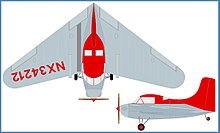Cornelius XFG-1
| XFG-1 | |
|---|---|

|
|
| Type: | Fuel cargo glider |
| Design country: | |
| Manufacturer: | |
| First flight: |
1944 |
| Number of pieces: |
2 |
The Cornelius XFG-1 was an American military fuel glider , that of George Cornelius developed in the 1940s and in the Cornelius Aircraft Company in Glendale was built, California. The FG in its name stood for F uel G lider and its role was to only transport fuel.
history
The XFG-1 was developed under the project code MX-416 and was an aerodynamically unusual aircraft and also intended for an unusual military task. In contrast to other cargo gliders such as the Waco CG-4 , the fuel transport glider could be towed by modern bombers at an airspeed (true airspeed, TAS) of 250 miles per hour.
description
The XFG-1 is a shoulder wing wing mounted far back at the end of the fuselage and had a fixed spring-loaded tripod landing gear. The cell had a closed conventional single seat cockpit. The flying wing had two fuselage tanks with a capacity of around 2800 liters. The XFG-1 could carry aviation fuel to temporary field airfields as well as motor fuel for military vehicles of the ground forces.
Two prototypes were built based on the Cornelius Mallard low wing aircraft and 32 flights were carried out in 1944 and 1945. The special feature of the swept wings was the ability to adjust the sweep angle, which was only possible on the ground before the flight. There were two variants of the wing adjustment with a 3˚ and 7f forward arrow . A boom with a propeller generator was mounted on the left side of the fuselage, which supplied the on-board electronics with power from the airflow. The standard instruments of the XFG-1 were a magnetic compass , altimeter , airspeed indicator , variometer , bubble level and a radio device.
Technical specifications
- Crew: 1 pilot
- Length: 8.92 m
- Span: 16.46 m
swell
- Gliding Gas Tank May Refuel Planes On Ocean Hops. Popular Science, August 1944, page 124. Online (English)
literature
- Bowers, Peter. M. Unconventional Aircraft. Blue Ridge Summit, PA: TAB Books, 1990. ISBN 978-0-8306-8450-2 .
- Fahey, James C. US Army Aircraft 1908-1946. New York: Ships and Aircraft, 1946.
